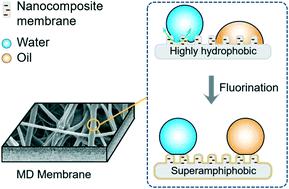当前位置:
X-MOL 学术
›
Environ. Sci.: Nano
›
论文详情
Our official English website, www.x-mol.net, welcomes your
feedback! (Note: you will need to create a separate account there.)
Development of robust and superamphiphobic membranes using reduced graphene oxide (rGO)/PVDF-HFP nanocomposite mats for membrane distillation
Environmental Science: Nano ( IF 5.8 ) Pub Date : 2021-08-10 , DOI: 10.1039/d1en00288k Tiantian Chen 1 , Wen Ma 2 , Jongho Lee 3 , David Jassby 4 , Md. Saifur Rahaman 1, 5
Environmental Science: Nano ( IF 5.8 ) Pub Date : 2021-08-10 , DOI: 10.1039/d1en00288k Tiantian Chen 1 , Wen Ma 2 , Jongho Lee 3 , David Jassby 4 , Md. Saifur Rahaman 1, 5
Affiliation

|
Membrane distillation (MD) has attracted significant attention owing to its unique advantages in desalination of hypersaline water. However, commercially available membranes used for MD desalination face fouling and wetting issues in treating wastewater containing low surface tension contaminants (e.g., oil and alcohol) and surface-active agents (e.g., surfactants). Herein, a superamphiphobic (i.e., superhydrophobic and near-superoleophobic) MD membrane was fabricated using the electrospinning technique followed by a simple surface modification step for treating challenging wastewater containing low surface tension substances. In order to fabricate a superamphiphobic membrane, a highly hydrophobic nanofibrous mat was first prepared by electrospinning a mixture of poly(vinylidene fluoride-co-hexafluoropropylene) (PVDF-HFP, also refers to PH) and reduced graphene oxide (rGO). Surface superamphiphobicity was then supplemented by a facile one-step grafting of low surface energy fluoroalkylsilane POTS. The influence of this one-step surface modification on the morphology and physicochemical properties of the membranes was investigated, revealing the altered elemental composition and enhanced hydrophobicity of the electrospun nanofiber mats. The resulting membranes demonstrated superamphiphobicity, confirmed by their wetting resistance evaluated with water and low surface tension liquids. The anti-wetting performance of the membrane was tested through desalinating 35 g L−1 sodium chloride solution in the presence of a surfactant (sodium dodecyl sulfate, SDS) in the direct contact membrane distillation (DCMD) unit. Membranes modified with fluoroalkylsilane (PH–rGO–POTS) exhibited enhanced stability and durability in terms of both permeation flux (∼27.94 kg m−2 h−1) and salt rejection (∼100%), while control membranes suffered from severe wetting problems.
中文翻译:

使用还原氧化石墨烯 (rGO)/PVDF-HFP 纳米复合垫开发用于膜蒸馏的坚固且超疏水的膜
膜蒸馏(MD)因其在超咸水淡化方面的独特优势而备受关注。然而,用于MD脱盐的市售膜在处理含有低表面张力污染物(例如油和醇)和表面活性剂(例如表面活性剂)的废水时面临结垢和润湿问题。在此,超疏水(即、超疏水和近超疏油)MD 膜是使用静电纺丝技术制造的,然后是一个简单的表面改性步骤,用于处理含有低表面张力物质的具有挑战性的废水。为了制造一个superamphiphobic膜,疏水性高的纳米纤维垫首先通过静电纺丝的聚(偏二氟的混合物制备的共-六氟丙烯)(PVDF-HFP,也指PH)和还原氧化石墨烯(rGO)。然后通过简单的一步接枝低表面能氟烷基硅烷 POTS 来补充表面超疏水性。研究了这种一步表面改性对膜的形态和物理化学性质的影响,揭示了电纺纳米纤维垫的元素组成改变和疏水性增强。由此产生的膜表现出超疏水性,这通过它们用水和低表面张力液体评估的耐湿性来证实。通过脱盐35 g L -1测试膜的抗润湿性能在直接接触膜蒸馏 (DCMD) 装置中,在表面活性剂(十二烷基硫酸钠,SDS)存在下的氯化钠溶液。用氟烷基硅烷 (PH-rGO-POTS) 改性的膜在渗透通量 (~27.94 kg m -2 h -1 ) 和盐截留率 (~100%)方面表现出更高的稳定性和耐久性,而对照膜存在严重的润湿问题.
更新日期:2021-08-25
中文翻译:

使用还原氧化石墨烯 (rGO)/PVDF-HFP 纳米复合垫开发用于膜蒸馏的坚固且超疏水的膜
膜蒸馏(MD)因其在超咸水淡化方面的独特优势而备受关注。然而,用于MD脱盐的市售膜在处理含有低表面张力污染物(例如油和醇)和表面活性剂(例如表面活性剂)的废水时面临结垢和润湿问题。在此,超疏水(即、超疏水和近超疏油)MD 膜是使用静电纺丝技术制造的,然后是一个简单的表面改性步骤,用于处理含有低表面张力物质的具有挑战性的废水。为了制造一个superamphiphobic膜,疏水性高的纳米纤维垫首先通过静电纺丝的聚(偏二氟的混合物制备的共-六氟丙烯)(PVDF-HFP,也指PH)和还原氧化石墨烯(rGO)。然后通过简单的一步接枝低表面能氟烷基硅烷 POTS 来补充表面超疏水性。研究了这种一步表面改性对膜的形态和物理化学性质的影响,揭示了电纺纳米纤维垫的元素组成改变和疏水性增强。由此产生的膜表现出超疏水性,这通过它们用水和低表面张力液体评估的耐湿性来证实。通过脱盐35 g L -1测试膜的抗润湿性能在直接接触膜蒸馏 (DCMD) 装置中,在表面活性剂(十二烷基硫酸钠,SDS)存在下的氯化钠溶液。用氟烷基硅烷 (PH-rGO-POTS) 改性的膜在渗透通量 (~27.94 kg m -2 h -1 ) 和盐截留率 (~100%)方面表现出更高的稳定性和耐久性,而对照膜存在严重的润湿问题.











































 京公网安备 11010802027423号
京公网安备 11010802027423号